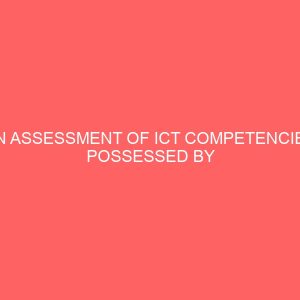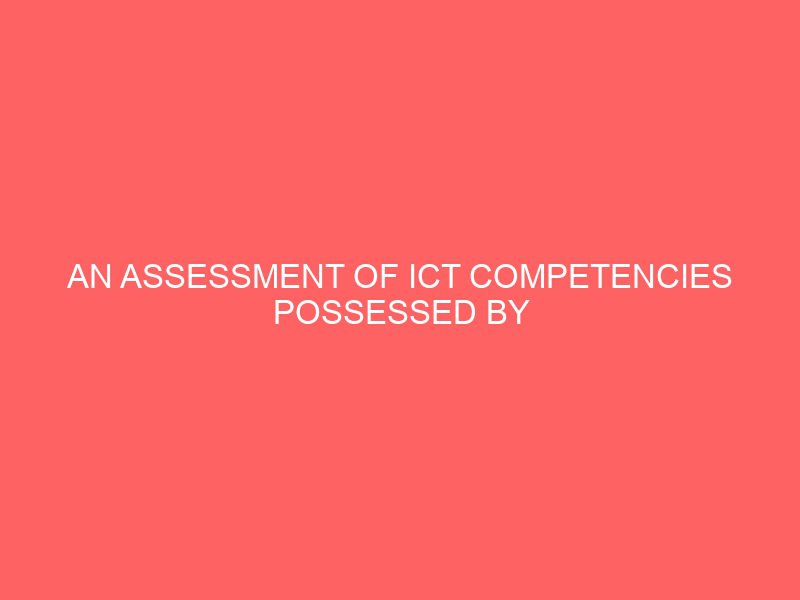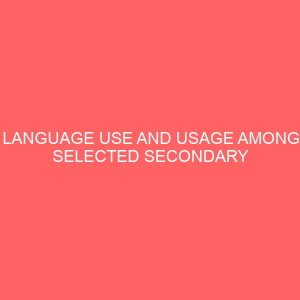Description
ABSTRACT
This study sought to ascertain the ICT competencies possessed by polytechnic OTM lecturers in the south eastern state of Nigeria. Five research questions were answered and five hypotheses tested. A total of 122 OTM lecturers in the seven government owned polytechnics in the south eastern states of Nigeria made up the population of the study and the population formed the sample for the study. The research instrument was a structured questionnaire titled ICT Competencies Possessed by polytechnic office technology and management OTM Lecturers. Four experts validated the instrument and a reliability test using Pearson product moment correlation coefficient yielded a reliability coefficient of 0.88. Mean rating was used to answer the research questions and ttest was used to test the hypotheses. Major findings included that majority of polytechnic OTM lecturers in the south eastern state in Nigeria had a moderate level of competence in word processing, spreadsheet and database management. Their level of competence in desktop publishing and web page design was low. The results revealed that male and female polytechnic OTM lecturers do not differ significantly in their mean ratings on the level of competence they possess in word processing, DTP, DBMS, and web page design applications. To encourage the acquisition of ICT competence by OTM lecturers, it was recommended that polytechnic management and the academic staff union of polytechnics ASUP should organize seminars and conferences to intimate OTM lecturers more on office application packages especially desktop and web page design. Any programme that does not meet the standard set by the Board NBTE as regards the right caliber of academic staffing in ICT should not be allowed to graduate students in the programme, ND and HND, as the case may be.
TABLE OF CONTENTS
TITLE PAGE i
APPROVAL PAGE ii
ACKNOWLEDGEMENT iii
ABSTRACT iv
TABLE OF CONTENTS v
LIST OF TABLES vii
LIST OF APPENDICES viii
CERTIFICATION ix
DEDICATION x
CHAPTER ONE
INTRODUCTION
Background to the Study 1
Statement of the Problem 6
Purpose of the Study 7
Significance of the Study 7
Scope of the Study 8
Research Questions 9
Null Hypotheses 9
CHAPTER TWO
REVIEW OF RELATED LITERATURE
Conceptual Framework 11
Theoretical Framework 24
Theoretical Studies 26
Empirical Studies 62
Summary of Review of Related Literature 66
CHAPTER THREE
METHOD
Research Design 69
Area of the Study 69
Population of the Study 69
Instrument for Data Collection 70
Validation of the Instrument 71
Reliability of the Instrument 72
Method of Data Collection 72
Method of Data Analysis 73
CHAPTER FOUR
PRESENTATION AND ANALYSIS OF DATA
Analysis of Research Questions 75
Statistical Analysis of Hypothesis 86
Summary of Major Findings 92
CHAPTER FIVE
DISCUSSION OF RESULTS, CONCLUSIONS AND RECOMMENDATIONS
Discussion of Results 94 Conclusions 99 Implications of the Study 100
Recommendations 101
Limitations of the Study 102 Suggestions for Further Research 102
REFERENCES 104
APPENDICES 110








Reviews
There are no reviews yet.